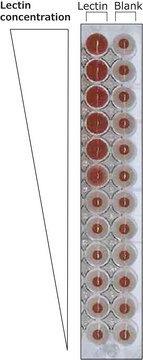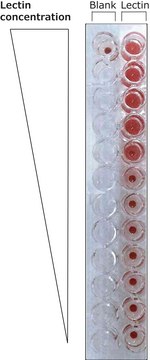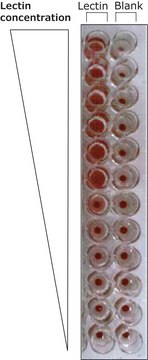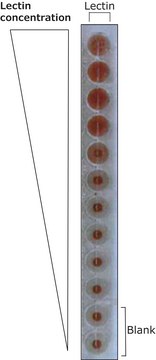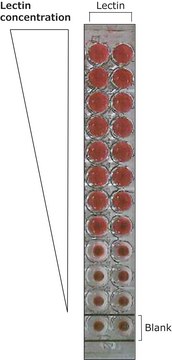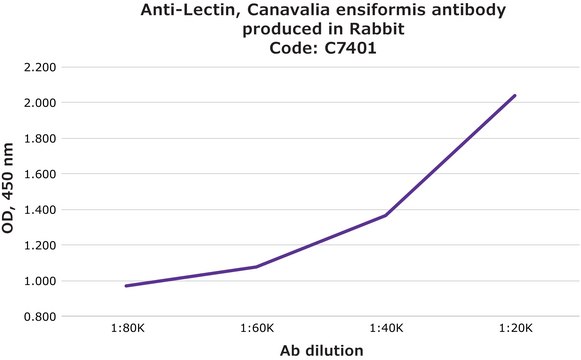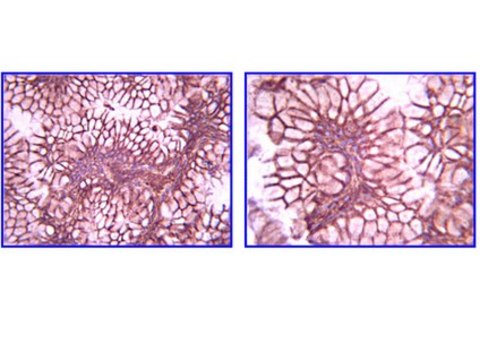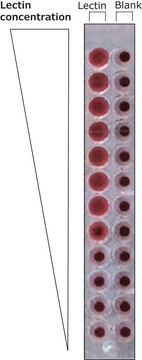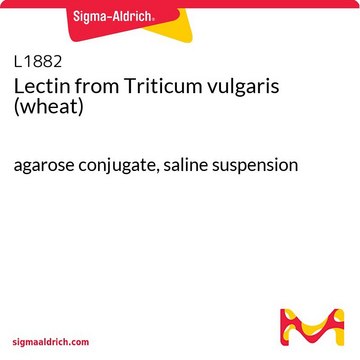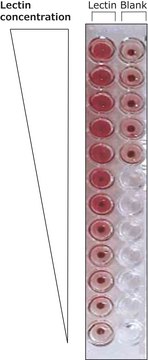T4144
Anti-Lectin, Triticum vulgaris antibody produced in rabbit
fractionated antiserum, lyophilized powder
Synonym(s):
Anti-WGA, Anti-Wheat germ lectin
Sign Into View Organizational & Contract Pricing
Select a Size
All Photos(1)
Select a Size
Change View
About This Item
Recommended Products
biological source
rabbit
Quality Level
conjugate
unconjugated
antibody form
fractionated antiserum
antibody product type
primary antibodies
clone
polyclonal
form
lyophilized powder
species reactivity
Triticum vulgaris
packaging
vial of 2 mL
technique(s)
indirect ELISA: 1:50,000
General description
Wheat germ lectin, also known as wheat germ agglutinin (WGA), has a molecular weight of 36 kDa. It shows affinity to 1,4-N-acetylglucosamine (GlcNAc) oligomers and is useful in studying surface components of C. neoformans.
Immunogen
Wheat Germ lectin (WGA)
Application
Anti-Lectin, Triticum vulgaris antibody produced in rabbit has been used in
- immunolabeling experiments
- immunohistochemistry
- immunocytochemistry
Anti-Lectin, Triticum vulgaris antibody produced in rabbit has been used in immunohistochemistry and immunocytochemistry.
Biochem/physiol Actions
Wheat germ agglutinin is a lectin isolated from Triticum vulgaris that has affinity for chitin oligosaccharides, peptidoglycans and glycolipids via sialic acid residues. It is not specific for human blood groups and has been identified as antagonists of botulinum and tetanus toxins.
Target description
Lectins are highly specific carbohydrate binding proteins useful in carbohydrate and cell membrane studies, as well as cell agglutination and typing techniques.
Physical form
Lyophilized from 0.01 M phosphate buffered saline, pH 7.2
Reconstitution
Reconstitute with 2 ml deionized water.
Disclaimer
Unless otherwise stated in our catalog or other company documentation accompanying the product(s), our products are intended for research use only and are not to be used for any other purpose, which includes but is not limited to, unauthorized commercial uses, in vitro diagnostic uses, ex vivo or in vivo therapeutic uses or any type of consumption or application to humans or animals.
Not finding the right product?
Try our Product Selector Tool.
Storage Class Code
12 - Non Combustible Liquids
WGK
WGK 3
Flash Point(F)
Not applicable
Flash Point(C)
Not applicable
Personal Protective Equipment
dust mask type N95 (US), Eyeshields, Gloves
Regulatory Information
常规特殊物品
Choose from one of the most recent versions:
Certificates of Analysis (COA)
Lot/Batch Number
Don't see the Right Version?
If you require a particular version, you can look up a specific certificate by the Lot or Batch number.
Already Own This Product?
Find documentation for the products that you have recently purchased in the Document Library.
A M Wu et al.
FEBS letters, 440(3), 315-319 (1999-01-01)
The binding profile of Triticum vulgaris (WGA, wheat germ) agglutinin to 23 O-glycans (GalNAc alpha1-->Ser/Thr containing glycoproteins, GPs) was quantitated by the precipitin assay and its specific interactions with O-glycans were confirmed by the precipitin inhibition assay. Of the 28
Detection of local and remote cellular damage caused by spinal cord and peripheral nerve injury using a heat shock signaling reporter system
Hashimoto-Torii K, et al.
IBRO reports, 5, 91-98 (2018)
N Bakry et al.
The Journal of pharmacology and experimental therapeutics, 258(3), 830-836 (1991-09-01)
Lectins from Anguilla anguilla, Artocarpus integrifolia, Canavalia ensiformis, Datora stramonium, Glycine max, Limax flavus, Ricinus communis and Triticum vulgaris were tested for their abilities to antagonize the binding of botulinum neurotoxin and tetanus toxin to rat brain membranes and to
Amygdala projections to the lateral bed nucleus of the stria terminalis in the macaque: comparison with ventral striatal afferents
decamp DM and Fudge JL
The Journal of Comparative Neurology, 521, 3191-3216 (2013)
Xiaomin Wei et al.
Cell death discovery, 10(1), 381-381 (2024-08-27)
Telomerase reverse transcriptase (Tert) has been found to have a protective effect on telomeric DNA, but whether it could improve the repair of reactive oxygen species (ROS)-induced DNA damage and promote myocardial regenerative repair after myocardial infarction (MI) by protecting
Our team of scientists has experience in all areas of research including Life Science, Material Science, Chemical Synthesis, Chromatography, Analytical and many others.
Contact Technical Service